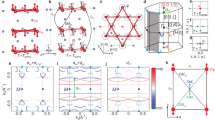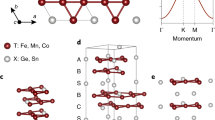Abstract
The introduction of localized electronic states into a metal can alter its physical properties, for example enabling exotic metal physics including heavy fermion and strange metal behaviour. A common source of localized states in such systems are partially filled 4f and 5f shells because of the inherently compact nature of those orbitals. The interaction of electrons in these orbitals with the conduction sea is well described by the Kondo framework. However, there have also been observations of Kondo-like behaviour in 3d transition metal oxides and in 4d- and 5d-containing van der Waals heterostructures. This calls for a broader consideration of the physical requirements for Kondo systems. Here we show transport and thermodynamic hallmarks of heavy fermion and strange metal behaviour that arise in the kagome metal Ni3In, wherein the source of localized states is destructive interference-induced band flattening of partially filled Ni 3d states. With magnetic field and pressure tuning, we also find evidence that the system is proximate to quantum criticality, extending the analogy to f-electron Kondo lattices. These observations highlight the role of hopping frustration in metallic systems as a potential source for strong correlations. Additionally, this suggests a lattice-driven approach to realizing correlated metals with non-trivial band topology.
This is a preview of subscription content, access via your institution
Access options
Access Nature and 54 other Nature Portfolio journals
Get Nature+, our best-value online-access subscription
$29.99 / 30 days
cancel any time
Subscribe to this journal
Receive 12 print issues and online access
$209.00 per year
only $17.42 per issue
Buy this article
- Purchase on Springer Link
- Instant access to full article PDF
Prices may be subject to local taxes which are calculated during checkout




Similar content being viewed by others
Data availability
The datasets for the main text are available in the Supplementary Information. All other data are available from the corresponding author on reasonable request. Source data are provided with this paper.
Code availability
The codes used to support the findings in this study are available from the corresponding author on reasonable request.
References
Baym, G. & Pethick, C. Landau Fermi-Liquid Theory: Concepts and Applications (Wiley, 2008).
Anderson, P. W. Basic Notions of Condensed Matter Physics (CRC Press, 2018).
Kondo, J. Resistance Minimum in Dilute Magnetic Alloys. Prog. Theor. Phys. 32, 37 (1964).
Doniach, S. The Kondo lattice and weak antiferromagnetism. Phys. B+C 91, 231 (1977).
Coleman, P. in Handbook of Magnetism and Advanced Magnetic Materials (eds Kronmuller, H. & Parkin, S.) pp 95–148 (Wiley, 2007).
Gegenwart, P., Si, Q. & Steglich, F. Quantum criticality in heavy-fermion metals. Nat. Phys. 4, 186–197 (2008).
Si, Q. & Steglich, F. Heavy fermions and quantum phase transitions. Science 329, 1161 (2010).
Phillips, P. W., Hussey, N. E. & Abbamonte, P. Stranger than metals. Science 377, eabh4273 (2022).
Proust, C. & Taillefer, L. The remarkable underlying ground states of cuprate superconductors. Annu. Rev. Condens. Matter Phys. 10, 409 (2019).
Jaoui, A. et al. Quantum critical behaviour in magic-angle twisted bilayer graphene. Nat. Phys. 18, 633–638 (2022).
Nayak, A. K. et al. Large anomalous Hall effect driven by a nonvanishing Berry curvature in the noncolinear antiferromagnet Mn3Ge. Sci. Adv. 2, e1501870 (2016).
Nakatsuji, S., Kiyohara, N. & Higo, T. Large anomalous Hall effect in a non-collinear antiferromagnet at room temperature. Nature 527, 212–215 (2015).
Ye, L. et al. Massive Dirac fermions in a ferromagnetic kagome metal. Nature 555, 638–642 (2018).
Kang, M. et al. Topological flat bands in frustrated kagome lattice CoSn. Nat. Commun. 11, 4004 (2020).
Ortiz, B. R. et al. CsV3Sb5: a z2 topological kagome metal with a superconducting ground state. Phys. Rev. Lett. 125, 247002 (2020).
Kang, M. et al. Twofold van Hove singularity and origin of charge order in topological kagome superconductor CsV3Sb5. Nat. Phys. 18, 301–308 (2022).
Kang, M. et al. Dirac fermions and flat bands in the ideal kagome metal FeSn. Nat. Mater. 19, 163–169 (2020).
Bergman, D. L., Wu, C. & Balents, L. Band touching from real-space topology in frustrated hopping models. Phys. Rev. B 78, 125104 (2008).
Tang, E., Mei, J.-W. & Wen, X.-G. High-temperature fractional quantum Hall states. Phys. Rev. Lett. 106, 236802 (2011).
Baranova, R. An electron diffraction study of the Ni–In system. Sov. Phys. Crystallogr. 10, 523–528 (1966).
Hausoel, A. et al. Local magnetic moments in iron and nickel at ambient and Earth’s core conditions. Nat. Commun. 8, 16062 (2017).
Stewart, G. Non-Fermi-liquid behavior in d- and f-electron metals. Rev. Mod. Phys. 73, 797 (2001).
Daou, R. et al. Linear temperature dependence of resistivity and change in the fermi surface at the pseudogap critical point of a high-tc superconductor. Nat. Phys. 5, 31–34 (2009).
Michon, B. et al. Thermodynamic signatures of quantum criticality in cuprate superconductors. Nature 567, 218–222 (2019).
Li, S. et al. Giant electron–electron scattering in the Fermi-liquid state of Na0.7CoO2. Phys. Rev. Lett. 93, 056401 (2004).
Jacko, A., Fjærestad, J. & Powell, B. A unified explanation of the Kadowaki–Woods ratio in strongly correlated metals. Nat. Phys. 5, 422–425 (2009).
Dagotto, E. Complexity in strongly correlated electronic systems. Science 309, 257 (2005).
Löhneysen, H. V. et al. Non-Fermi-liquid behavior in a heavy-fermion alloy at a magnetic instability. Phys. Rev. Lett. 72, 3262 (1994).
Hu, D. et al. ω/T scaling and magnetic quantum criticality in \({{{{\rm{BaFe}}}}}_{2}{({{{{\rm{As}}}}}_{0.7}{{{{\rm{P}}}}}_{0.3})}_{2}\). Preprint at https://arxiv.org/abs/1812.11902 (2018).
Moriya, T. Recent progress in the theory of itinerant electron magnetism. J. Magn. Magn. Mater. 14, 1 (1979).
Coleman, P. & Nevidomskyy, A. H. Frustration and the Kondo effect in heavy fermion materials. J. Low. Temp. Phys. 161, 182 (2010).
Chen, L. et al. Emergent flat band and topological Kondo semimetal driven by orbital-selective correlations. Preprint at https://arxiv.org/abs/2212.08017 (2022).
Motrunich, O. I. Variational study of triangular lattice spin-1/2 model with ring exchanges and spin liquid state in \(\upkappa \text{-}{({{{\rm{ET}}}})}_{2}{{{{\rm{Cu}}}}}_{2}{({{{\rm{CN}}}})}_{3}\). Phys. Rev. B 72, 045105 (2005).
Zhao, H. et al. Quantum-critical phase from frustrated magnetism in a strongly correlated metal. Nat. Phys. 15, 1261–1266 (2019).
Sales, B. C. et al. Chemical control of magnetism in the kagome metal \({{{{\rm{CoSn}}}}}_{1-x}{{{{\rm{In}}}}}_{x}\) : magnetic order from nonmagnetic substitutions. Chem. Mater. 34, 7069 (2022).
Smith, J. & Kmetko, E. Magnetism or bonding: a nearly periodic table of transition elements. J. Less Common Met. 90, 83 (1983).
Kondo, S. et al. LiV2O4: a heavy fermion transition metal oxide. Phys. Rev. Lett. 78, 3729 (1997).
Vaňo, V. et al. Artificial heavy fermions in a van der Waals heterostructure. Nature 599, 582–586 (2021).
Zhao, W. et al. Gate-tunable heavy fermions in a moiré Kondo lattice. Nature 616, 61–65 (2023).
Chen, L. et al. Topological semimetal driven by strong correlations and crystalline symmetry. Nat. Phys. 18, 1341–1346 (2022).
Song, Z.-D. & Bernevig, B. A. Magic-angle twisted bilayer graphene as a topological heavy fermion problem. Phys. Rev. Lett. 129, 047601 (2022).
Regnault, N. et al. Catalogue of flat-band stoichiometric materials. Nature 603, 824–828 (2022).
Kresse, G. & Furthmüller, J. Efficient iterative schemes for ab initio total-energy calculations using a plane-wave basis set. Phys. Rev. B 54, 11169 (1996).
Kresse, G. & Furthmüller, J. Efficiency of ab-initio total energy calculations for metals and semiconductors using a plane-wave basis set. Comput. Mater. Sci. 6, 15 (1996).
Blöchl, P. E. Projector augmented-wave method. Phys. Rev. B 50, 17953 (1994).
Perdew, J. P., Burke, K. & Ernzerhof, M. Generalized gradient approximation made simple. Phys. Rev. Lett. 77, 3865 (1996).
Mostofi, A. A. et al. wannier90: a tool for obtaining maximally-localised Wannier functions. Comput. Phys. Commun. 178, 685 (2008).
Mostofi, A. A. et al. An updated version of wannier90: a tool for obtaining maximally-localised Wannier functions. Comput. Phys. Commun. 185, 2309 (2014).
Marzari, N., Mostofi, A. A., Yates, J. R., Souza, I. & Vanderbilt, D. Maximally localized Wannier functions: theory and applications. Rev. Mod. Phys. 84, 1419 (2012).
Koepernik, K. & Eschrig, H. Full-potential nonorthogonal local-orbital minimum-basis band-structure scheme. Phys. Rev. B 59, 1743 (1999).
Eschrig, H. & Koepernik, K. Tight-binding models for the iron-based superconductors. Phys. Rev. B 80, 104503 (2009).
Acknowledgements
We appreciate fruitful discussions with T. Senthil, B. J. Yang, L. Zou, Y. Zhang, K. Haule, J.-S. You, J. van den Brink, O. I. Motrunich, S. Bühler-Paschen, Q. Si, C. Varma and M. Kriener. L.Y. acknowledges assistance from M.K. Chan for pulsed field magnetization measurements. D.C.B. acknowledges help from A. Akey for TEM sample preparation. This research is funded in part by the Gordon and Betty Moore Foundation EPiQS Initiative, through grants GBMF3848 and GBMF9070 to J.G.C. (material synthesis), NSF grant DMR-1554891 (material design), ARO grant no. W911NF-16-1-0034 (technique development) and the Air Force Office of Scientific Research under award FA9550-22-1-0432 (advanced material analysis). L.Y., M.K. and E.K. acknowledge support by the STC Center for Integrated Quantum Materials, NSF grant number DMR-1231319. L.Y. acknowledges the Heising-Simons Physics Research Fellow Program and the Tsinghua Education Foundation. S.F. is partially supported by a Rutgers Center for Material Theory Distinguished Postdoctoral Fellowship. M.K. acknowledges support from the Samsung Scholarship from the Samsung Foundation of Culture. R.C. acknowledges support from the Alfred P. Sloan Foundation. O.J. was supported by the Leibniz Association through the Leibniz Competition. A portion of this work was performed at the National High Magnetic Field Laboratory, which is supported by National Science Foundation cooperative agreement no. DMR-1644779, the State of Florida and the Department of Energy (DOE). Pulsed magnetic field measurements at Los Alamos National Laboratory were supported by the US Department of Energy BES Science at 100T grant. This research used the resources of the Advanced Light Source, a US DOE Office of Science User Facility under contract no. DE-AC02-05CH11231. The computations in this paper were run on the ITF/IFW computer clusters (Dresden, Germany) and the FASRC Cannon cluster supported by the FAS Division of Science Research Computing Group at Harvard University. We thank U. Nitzsche for technical assistance in maintaining computing resources at IFW Dresden. This work was performed in part at the Aspen Center for Physics, which is supported by National Science Foundation grant PHY-1607611.
Author information
Authors and Affiliations
Contributions
L.Y. and J.G.C. designed the study. L.Y. synthesized and characterized the single crystalline and polycrystalline materials, and performed and analysed the physical property measurements, with C.J. (hydrostatic pressure measurements), P.M.N. (rotation measurements) and S.Y.F.Z. (low temperature measurements). S.F., J.K., O.J. and E.K. performed the first principles analysis. M.K., Y.L. and R.C. performed the photoemission experiments and analysis with the assistance of J.D., C.J., A.B. and E.R. J.D. guided the process of sample surface preparation. D.C.B. performed the transmission electron microscopy measurements. L.Y. and J.G.C. wrote the manuscript with input from all the other authors.
Corresponding author
Ethics declarations
Competing interests
The authors declare no competing interests.
Peer review
Peer review information
Nature Physics thanks William Meier and the other, anonymous, reviewers for their contribution to the peer review of this work.
Additional information
Publisher’s note Springer Nature remains neutral with regard to jurisdictional claims in published maps and institutional affiliations.
Supplementary information
Supplementary Information
Supplementary Sections 1–11 and Figs. S1–23.
Source data
Rights and permissions
Springer Nature or its licensor (e.g. a society or other partner) holds exclusive rights to this article under a publishing agreement with the author(s) or other rightsholder(s); author self-archiving of the accepted manuscript version of this article is solely governed by the terms of such publishing agreement and applicable law.
About this article
Cite this article
Ye, L., Fang, S., Kang, M. et al. Hopping frustration-induced flat band and strange metallicity in a kagome metal. Nat. Phys. 20, 610–614 (2024). https://doi.org/10.1038/s41567-023-02360-5
Received:
Accepted:
Published:
Issue Date:
DOI: https://doi.org/10.1038/s41567-023-02360-5
This article is cited by
-
Crystal net catalog of model flat band materials
npj Computational Materials (2024)
-
A strange way to get a strange metal
Nature Physics (2024)
-
Flat bands, strange metals and the Kondo effect
Nature Reviews Materials (2024)



